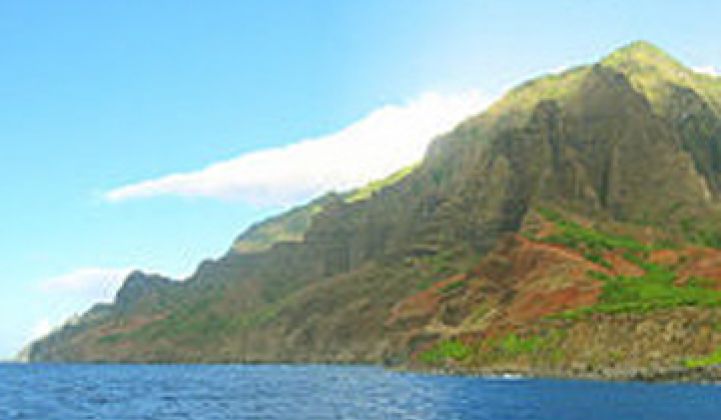Solar installer and financier SolarCity has historically addressed the residential and small commercial market.
But SolarCity was just chosen by the Kauai Island Utility Cooperative (KIUC) to construct a 14-megawatt (DC) solar photovoltaic power plant on land owned by Grove Farm. It's a $40 million project that will use more than 50,000 panels on 67 acres of the tropical island. The project is still in the planning stages and won't commence construction until mid-2013, pending regulatory approvals, so vendors and technologies have not yet been selected. It's the first utility-scale deal won by SolarCity.
GTM Research Solar Analyst Andrew Krulewitz comments, "Continuing a trend that we've seen in SolarCity's non-residential business, where systems have grown from ~50 kilowatts on average two years ago to the company now regularly connecting projects of one megawatt or more, it was only a matter of time before SolarCity tossed its hat in the utility-scale ring." Krulewitz notes that 14 megawatts for $40 million works out to an installed cost of $2.85 per watt, which "isn't bad, but it's not industry-leading either."
SolarCity is in its pre-IPO quiet period and is even less communicative than usual. Rob Day took a deep look at the solar installer and financier's SEC paperwork here.
The location of the project, Grove Farm, is a community development and property management company near the town of Koloa. The Grove Farm project is one of three planned by the KIUC, which will result in a total of 30 megawatts of generation capacity being in place by 2023 -- about half the daytime energy demand of Kauai. SolarCity has already done some work on Kauai -- at the Lihue airport, at military homes, and at the University of Hawaii.
In conversations with installers on the ground in Hawaii, we've learned that salt air and moisture places more demands on electronics and materials in a solar installation -- so much so that warranty times for systems hardware are shorter than on the mainland. This applies to panels as well as inverters.
KIUC is a member-owned cooperative with 33,000 customers. We spoke with Jim Kelly, Communications Manager at KIUC. The island has an average peak load of 65 megawatts and more than 100 megawatts of capacity.
Approximately 89 percent of that power is now furnished by oil-fired generation. Kelly said the average customer cost for electricity is $0.43 per kilowatt-hour, with an average bill of $200 per month for roughly 480 kilowatt-hours, which is "attributable to the cost of oil," in Kelly's words. Kauai has a goal of generating 50 percent of its energy from renewable sources by 2023.
Kelly acknowledged that island grids tend to be fragile and that the co-op's engineers are working "12 hours a day" to be able to handle the realities of distributed generation. That includes battery storage, which is currently under consideration, according to Kelly.
He said that there was "a new sense of urgency to get these renewables built and on-line. It's been difficult in the last decade to get from the talking-stage to the building-stage. Finance has been especially challenging. It's great that we're starting to turn dirt and get these projects on-line."
Kelly said that on an island like Kauai, "Even small projects make an impact," adding, "It means there's a lot of oil we're not going to buy."
Carolyn Campbell, Solar Analyst at GTM Research, recently published some preliminary work on solar in the U.S. after the Investment Tax Credit recedes. States with high electricity costs and lots of sun, like Hawaii, are better positioned to continue growth in the solar sector.



